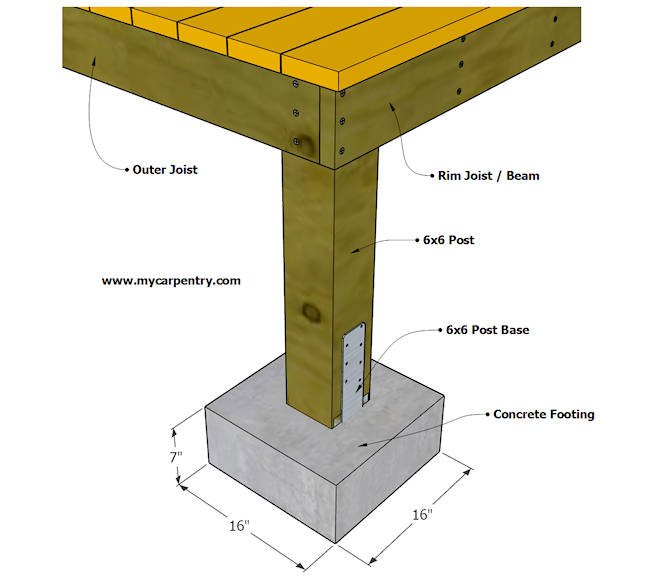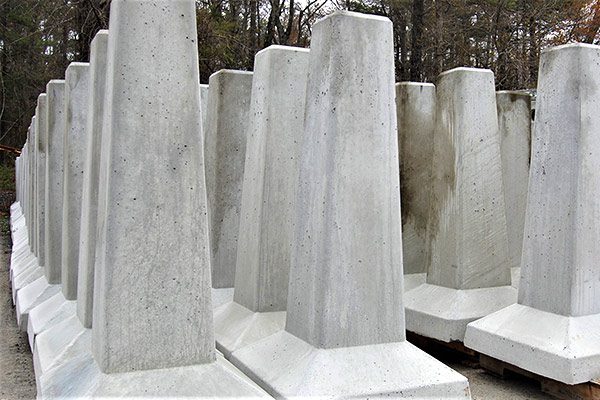Choosing the Right Deck Footings for Security and Durability
The durability and safety of your deck depend greatly on the type of footings you select, as they give the essential support and stability to withstand the test of time. In this conversation, we will discover the different types of deck grounds, take into consideration the important variables to evaluate when making a choice, and dig into the pros and disadvantages of different alternatives.
Kinds of Deck Grounds
There are a number of sorts of deck footings that can be utilized, each offering special advantages and considerations. One typical kind of footing is the concrete pier ground. These footings include a cylindrical opening filled up with concrete, which gives a strong structure for the deck messages. Concrete pier grounds are reasonably easy to mount and use excellent stability, making them a prominent option for numerous deck projects.
An additional kind of footing is the helical heap footing. Helical stacks are steel shafts with helical plates affixed to them. These grounds are set up by screwing them into the ground, which develops a secure structure for the deck. Helical stack footings are perfect for locations with difficult soil conditions, as they can be mounted in practically any type of sort of soil. If required., they additionally enable for easy modification and leveling of the deck.
Alternatively, some builders go with precast concrete grounds. These grounds are made of resilient concrete and can be found in various sizes and shapes to accommodate various deck styles. Precast concrete grounds are convenient to install and provide a secure base for the deck structure.
Finally, an additional choice is the post-in-anchor footing system. This type of ground involves driving a steel support into the ground and connecting it to the deck post. It offers adaptability in regards to positioning the deck articles and appropriates for decks with light-weight structures.
When selecting the right kind of deck ground, it is important to take into consideration aspects such as soil conditions, deck lots, and regional building ordinance (Deck Footings). Consulting with an expert specialist or structural designer can assist guarantee the ideal footing is picked for a stable and risk-free deck
Aspects to Think About When Picking Footings
When picking the proper grounds for a deck, it is important to very carefully take into consideration numerous factors such as dirt problems, deck load, and adherence to local building codes. These variables play a significant function in making certain the stability and resilience of the deck framework.
One of the main variables to think about is the soil conditions. The kind of soil on which the deck will certainly be developed figures out the sort of footings required. Decks built on sandy or loosened soils may require much deeper grounds to supply sufficient assistance and avoid settling. On the various other hand, decks developed on clay or extensive soils might call for grounds that can fit the dirt's propensity to increase and agreement.
Another vital factor is the deck load. The weight of the deck, including the products used and any kind of potential live tons such as furniture or events, must be considered when selecting footings. The grounds must be made to birth the weight of the deck and distribute it equally to avoid any structural concerns or failings.
Finally, adherence to neighborhood building regulations is vital. Building ordinance differ from area to region, and it check these guys out is important to follow the certain requirements established by the regional authorities. Deck Footings. These codes make sure that the deck is constructed securely and fulfills the essential standards for structural stability and load-bearing capability
Concrete Footings: Disadvantages and pros

Concrete grounds use a number of advantages and downsides when utilized as the foundation for a deck. On the positive side, concrete footings offer outstanding security and sturdiness.
One more advantage of concrete footings is their adaptability. They can be put right into various sizes and shapes to fit numerous deck designs and arrangements. Concrete footings can be tailored to fit the specific demands and demands of the deck framework.
Nevertheless, there are additionally some downsides to utilizing concrete footings. This can enhance the general price of the deck job and may need expert support.

Helical Piers Vs. Sonotubes: Which Is Better?
In considering the structure alternatives for a deck, the comparison in between helical piers and sonotubes is crucial in determining the premium choice. They are turned into the ground making use of hydraulic machinery, supplying a steady and durable foundation for the deck.
When it pertains to security and durability, helical piers have the upper hand. The helical plates on the piers develop a strong hold with the dirt, moving or preventing any motion of the deck. This is specifically valuable in locations with unstable or changing dirt conditions. Sonotubes, on the various other hand, count solely on the concrete loading for stability, which might not provide the exact same level of stamina and resistance.
In regards to installation, helical piers are relatively much easier and faster to set up compared to sonotubes. The hydraulic machinery used to turn the piers right into the ground makes sure a efficient and quick process. Sonotubes, on the other hand, require digging openings and pouring concrete, which can be taxing and labor-intensive.
Furthermore, helical piers are an even more versatile alternative. They can be made use of in different dirt problems and can be readjusted or strengthened if needed. Sonotubes, on the other hand, might need additional support, such as rebar, in particular soil Learn More problems or locations with high load requirements.
Picking the Right Footings for Your Deck's Measurements
For optimum structural stability, it is necessary to very carefully choose the appropriate grounds that align with the measurements of your deck. The dimensions of your deck, including its elevation, size, and length, play a substantial role in figuring out the kind and dimension of grounds needed.
When selecting footings for your deck, it is necessary to think about the load-bearing ability of the dirt. The weight of the deck, combined with the weight of any type of furniture or people on it, exerts a significant pressure on the grounds (Deck Footings). As a result, it is vital to choose footings that can properly support go now this weight without moving or sinking in time.
Bigger decks with better measurements call for larger footings to supply enough security and assistance. The form of the grounds, whether they are round or square, depends on the layout and design of the deck.
Verdict
Finally, picking the ideal deck footings is vital for making certain stability and resilience. Aspects such as the kind of footings, the deck's dimensions, and the pros and disadvantages of different options need to be thought about. Concrete grounds offer stamina and long life, however might be much more lengthy and costly to install. Helical piers and sonotubes have their very own benefits and downsides. Eventually, picking the suitable footings for your deck's certain needs is essential for a lasting and successful framework.
These grounds consist of a cylindrical opening loaded with concrete, which offers a solid structure for the deck messages. Concrete pier grounds are relatively very easy to mount and offer superb stability, making them a popular selection for several deck jobs.
Precast concrete grounds are convenient to mount and offer a secure base for the deck structure.
It supplies adaptability in terms of positioning the deck messages and is ideal for decks with light-weight structures.
Concrete footings offer several benefits and negative aspects when made use of as the foundation for a deck.